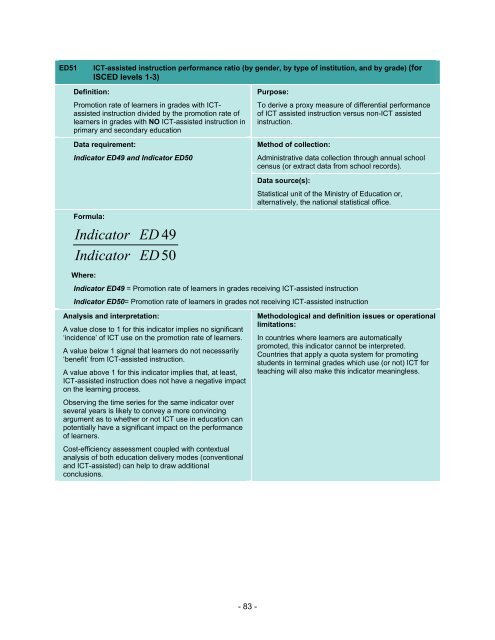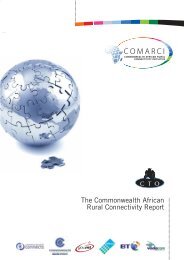Guide to measuring information and ... - unesdoc - Unesco
Guide to measuring information and ... - unesdoc - Unesco
Guide to measuring information and ... - unesdoc - Unesco
Create successful ePaper yourself
Turn your PDF publications into a flip-book with our unique Google optimized e-Paper software.
ED51 ICT-assisted instruction performance ratio (by gender, by type of institution, <strong>and</strong> by grade) (for<br />
ISCED levels 1-3)<br />
Definition:<br />
Promotion rate of learners in grades with ICTassisted<br />
instruction divided by the promotion rate of<br />
learners in grades with NO ICT-assisted instruction in<br />
primary <strong>and</strong> secondary education<br />
Data requirement:<br />
Indica<strong>to</strong>r ED49 <strong>and</strong> Indica<strong>to</strong>r ED50<br />
Formula:<br />
Indica<strong>to</strong>r<br />
Indica<strong>to</strong>r<br />
Where:<br />
ED<br />
ED<br />
49<br />
50<br />
- 83 -<br />
Purpose:<br />
To derive a proxy measure of differential performance<br />
of ICT assisted instruction versus non-ICT assisted<br />
instruction.<br />
Method of collection:<br />
Administrative data collection through annual school<br />
census (or extract data from school records).<br />
Data source(s):<br />
Statistical unit of the Ministry of Education or,<br />
alternatively, the national statistical office.<br />
Indica<strong>to</strong>r ED49 = Promotion rate of learners in grades receiving ICT-assisted instruction<br />
Indica<strong>to</strong>r ED50= Promotion rate of learners in grades not receiving ICT-assisted instruction<br />
Analysis <strong>and</strong> interpretation:<br />
A value close <strong>to</strong> 1 for this indica<strong>to</strong>r implies no significant<br />
‘incidence’ of ICT use on the promotion rate of learners.<br />
A value below 1 signal that learners do not necessarily<br />
‘benefit’ from ICT-assisted instruction.<br />
A value above 1 for this indica<strong>to</strong>r implies that, at least,<br />
ICT-assisted instruction does not have a negative impact<br />
on the learning process.<br />
Observing the time series for the same indica<strong>to</strong>r over<br />
several years is likely <strong>to</strong> convey a more convincing<br />
argument as <strong>to</strong> whether or not ICT use in education can<br />
potentially have a significant impact on the performance<br />
of learners.<br />
Cost-efficiency assessment coupled with contextual<br />
analysis of both education delivery modes (conventional<br />
<strong>and</strong> ICT-assisted) can help <strong>to</strong> draw additional<br />
conclusions.<br />
Methodological <strong>and</strong> definition issues or operational<br />
limitations:<br />
In countries where learners are au<strong>to</strong>matically<br />
promoted, this indica<strong>to</strong>r cannot be interpreted.<br />
Countries that apply a quota system for promoting<br />
students in terminal grades which use (or not) ICT for<br />
teaching will also make this indica<strong>to</strong>r meaningless.
















